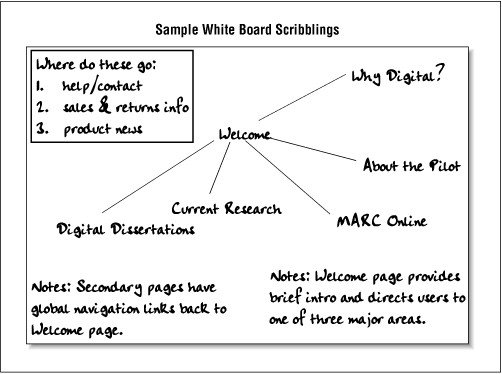 | Information Architecture for the World Wide Web |  |

Brainstorming with White Boards and Flip Charts
Metaphor Exploration
Scenarios
High-Level Architecture Blueprints
Architectural Page Mockups
Design Sketches
Web-Based Prototypes
Based upon information gathered during the research phase, you must now create order out of chaos. Is there a metaphor that will drive the organization of the site? How should the information be organized and labeled at the highest levels of the hierarchy? What types of navigation systems will be applied? How will searching work? This is where the fun begins.
Early conceptual design meetings focus on metaphor and high-level organization. You need to present possible organization schemes, balancing the desire to reach consensus and move forward with the need to remain open-minded about alternate approaches. White boards and flip charts, high-level architecture blueprints, and scenarios are key tools at this stage. After the major issues have been worked out, later meetings involve the consideration of more detailed organization, labeling, indexing, and navigation systems. Detailed blueprints and Web-based prototypes will serve you well in these discussions.
For collaborative purposes, white boards are unparalleled. The ephemeral nature of white board scribblings permits a creative freedom not found in other media. The technology disappears and inhibitions fall away.
In early research-oriented meetings, white boards support collaboration around the definition and refinement of the mission, vision, and goals of the project. When working with several people from the organization, each with a different set of experiences, perspectives, and goals, you can use the white board to help identify issues, resolve differences, and achieve consensus.
White boards are also useful for considering possible information architectures. Presenting ideas on the white board triggers new understanding and further brainstorming (see Figure 8-1). The white board, the architect, and colleagues become connected in a feedback cycle that moves towards the articulation of an information architecture.

At face level, a major problem of white boards revolves around the difficulty of recording a white-boarding session. White board scribblings do not leave a permanent record. Ideas flow. The board fills up. The board is erased. Eventually, everyone leaves and the scribblings remain trapped on the surface of the white board, soon to be erased by the participants of the next meeting.
In reality, you can use this problem to your advantage. Each time consensus is reached, record the relevant white board scribblings. Differences of opinion and dead-end discussions are quickly forgotten and only the agreements remain. Alternatively, if you're not comfortable with this level of sneakiness, you can assign a designated notetaker to record agreements and disagreements alike.
We are aware of high-tech white boards that allow you to print or save your scribbles. While we don't have much direct experience, we're guessing many of these gadgets are more trouble than they're worth. Sorry for the skepticism, but what do you expect from librarians?
While the flip chart is a close relative of the white board, several characteristics distinguish the two. Advantages of using the flip chart during the research phase include its high portability and intrinsic record-generating nature. Flip charts are portable. Their tearaway sheets can be taken back to the office for study and transcription. White boards are often anchored to walls and won't fit in your car.
However, flip charts don't really support iteration and collaboration. Due to the difficulty of erasing ink on paper and the ugliness of extensively marked-up pages, flip charts invoke in people a higher fear of error and greater resistance to change. When working with flip charts, people try to get it right the first time. Whether or not they succeed, they tend to live with the results rather than mark up the page. This limits the freedom and creativity of group collaboration.
While the visible differences between white boards and flip charts are fairly subtle and seemingly innocent, the ultimate impact upon the collaborative process can be significant. For collaborative brainstorming, give us a white board any day.

Copyright © 2002 O'Reilly & Associates. All rights reserved.